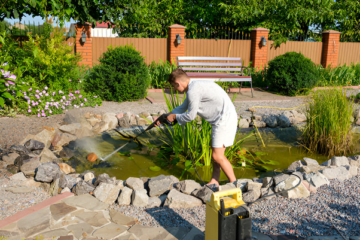Asbestos in Home Tool Sheds

Historical Use of Asbestos in Construction
Asbestos has a long history in construction, prized for its durability and resistance to heat. Back in the day, builders used it extensively in homes, including tool sheds, because it was cheap and effective at insulating and fireproofing. Before the health risks were known, it was the go-to material for a lot of things. Roofs, walls, and even some flooring materials often had asbestos in them. This was especially true during the mid-20th century when its use peaked. However, as the dangers became clear, regulations began to limit its use, culminating in bans in many countries.
Common Asbestos-Containing Materials
In many older sheds, you might find asbestos in several common materials. These include:
- Roofing materials: Asbestos was often mixed into cement for corrugated roofing sheets, which were popular in sheds.
- Insulation: Used for its heat-resistant properties, asbestos insulation was common in walls and ceilings.
- Cement products: Asbestos cement was a staple in construction, used in pipes, panels, and even some types of siding.
These materials were chosen for their strength and resistance to weather and wear, making them ideal for outdoor structures like sheds.
Health Risks Associated with Asbestos
The health risks of asbestos are serious and well-documented. When asbestos-containing materials become damaged, they release tiny fibers into the air. If inhaled, these fibers can cause severe respiratory diseases. One of the most dangerous is mesothelioma, a cancer linked directly to asbestos exposure. Other conditions include lung cancer and asbestosis, a chronic lung disease. These health issues often take years to develop, making early exposure particularly concerning. It’s crucial to manage and, if necessary, remove asbestos safely to protect your health and that of your family.
Identifying Asbestos in Your Tool Shed
Visual Indicators of Asbestos
When trying to spot asbestos in your tool shed, visual inspection alone might not be enough. Asbestos-containing materials (ACMs) often look similar to non-asbestos materials. However, there are some signs to watch for. Asbestos cement sheets, for instance, generally start as gray or off-white but weather into a dull, textured surface over time. Noticing these color changes and stains can help determine if your shed’s roof contains asbestos. Also, check for signs of wear and tear, as asbestos materials tend to become friable when damaged, posing a greater health risk.
Common Locations for Asbestos in Sheds
Asbestos can be found in various places within a tool shed. Here are some common spots:
- Roofing and siding: Often made from asbestos cement, which was popular for its durability.
- Floor tiles: Older vinyl tiles might contain asbestos, especially if installed before the 1980s.
- Insulation materials: Used around pipes or as part of the shed’s structure.
Knowing these common locations can assist in identifying potential asbestos hazards in your shed.
Tools for Asbestos Detection
Detecting asbestos isn’t something to take lightly, and it’s best left to professionals. However, if you’re keen on preliminary checks, here are some tools that might help:
- Asbestos testing kits: Available for purchase, these kits allow you to collect samples safely and send them to a lab for analysis.
- Moisture meter: Helps identify areas where water damage may have made asbestos materials friable.
- Protective gear: Always use masks and gloves when handling suspected asbestos materials to minimize exposure.
Remember, if you suspect asbestos presence, it’s always safer to consult with a certified professional for a thorough inspection and testing.
Health Risks of Asbestos Exposure
Respiratory Diseases Linked to Asbestos
When asbestos fibers are inhaled, they can become lodged deep within the lungs, leading to a range of serious respiratory diseases. Over time, these fibers cause inflammation and scarring in lung tissues. One of the most common diseases is asbestosis, a chronic lung condition characterized by severe scarring and inflammation. This condition can lead to further respiratory issues, such as chronic obstructive pulmonary disease (COPD), which can be life-threatening.
Long-Term Health Implications
The long-term health effects of asbestos exposure are particularly concerning due to their severity and the time it takes for symptoms to appear. Many people may not notice any signs until decades after their exposure. Mesothelioma, a rare and aggressive cancer affecting the lining of the lungs, is one of the most severe consequences. Additionally, those exposed to asbestos are at a heightened risk of developing lung cancer, especially if they have a history of smoking. Short-term exposure to asbestos dust can also result in significant health risks, though the likelihood of developing cancer from brief exposure is lower unless the exposure is intense.
Preventive Measures for Homeowners
To safeguard against asbestos-related health risks, homeowners should take proactive steps. Here are some essential measures:
- Regular Inspections: Conduct regular inspections of your home, especially if it was built before the 2000s, to identify potential asbestos materials.
- Avoid Disturbing Asbestos: If you suspect asbestos in your home, avoid disturbing the materials as this can release harmful fibers into the air.
- Professional Help: Consider hiring certified professionals for asbestos testing and removal to ensure safety and compliance with regulations.
- Educate Family Members: Make sure everyone in the household is aware of the dangers of asbestos and the importance of not disturbing any suspicious materials.
By understanding these health risks and taking preventive actions, homeowners can significantly reduce the danger posed by asbestos exposure.
Legal Guidelines for Asbestos Management
Regulations on Asbestos Use
In the United States, asbestos management is governed by strict regulations to protect public health. One of the key regulations is the final rule established in April 2019, which prohibits certain uses of asbestos that are no longer available in the market. Compliance with these regulations is mandatory for anyone handling asbestos, whether in a residential or commercial setting. Failure to adhere to these rules can lead to severe penalties. Homeowners, contractors, and businesses must ensure they are up-to-date with these laws to avoid legal troubles.
Legal Obligations for Homeowners
Homeowners have specific legal responsibilities when it comes to asbestos in their properties. If asbestos is present, they must ensure it is managed safely and in accordance with local regulations. This often means hiring certified professionals for inspection and removal. Homeowners must also notify local authorities before any removal work begins and may need to obtain permits. Ignoring these obligations not only endangers health but also risks legal action.
Penalties for Non-Compliance
Penalties for failing to comply with asbestos regulations can be significant. They may include hefty fines, legal action, and even criminal charges in severe cases. Homeowners should be aware that non-compliance not only affects them financially but can also have long-term implications for their property’s value and safety. Ensuring compliance is not just a legal requirement but a critical step in safeguarding health and property.
Professional Asbestos Inspection and Testing
Choosing a Certified Asbestos Inspector
Hiring a certified asbestos inspector is a smart move for homeowners looking to ensure their property is safe. These professionals have the expertise to conduct thorough inspections and identify potential asbestos-containing materials. It’s crucial to choose an inspector who is certified and experienced, as they will provide a comprehensive report detailing the presence and condition of asbestos in your tool shed.
Understanding Asbestos Testing Methods
Once you’ve selected an inspector, understanding the testing methods they use can be beneficial. Typically, inspectors will take samples of suspected materials and send them to a lab for analysis. One reliable option is an asbestos test kit, which offers a cost-effective way to test for asbestos. It includes lab fees and provides quick results, making it a popular choice among homeowners.
Interpreting Test Results
After testing, you’ll receive a report with the results. It’s important to understand what these results mean for your home. If asbestos is found, the inspector will offer recommendations on how to manage or remove it safely. In some cases, if the asbestos is not disturbed and is in good condition, it may be best to leave it alone. However, if it’s damaged or likely to be disturbed, removal by a licensed professional is advised. Interpreting these results accurately is key to making informed decisions about your home’s safety.
Safe Asbestos Removal Practices
Hiring Licensed Asbestos Removalists
When it comes to removing asbestos, hiring a licensed asbestos removalist is the safest route. These professionals are trained to handle asbestos-containing materials properly, ensuring that the dangerous fibers do not become airborne. Before starting the removal process, it’s often required to notify local authorities, and sometimes permits are needed. Many asbestos removal companies can manage this paperwork for you. They will set up a containment zone using plastic sheeting and negative air pressure systems to prevent any fibers from escaping. It’s crucial to hire a certified contractor to avoid health risks and legal issues.
DIY Asbestos Removal: Risks and Precautions
While it’s possible to remove asbestos yourself, it’s not recommended due to the high health risks involved. If you decide to go this route, you must follow strict safety precautions:
- Line your work area with a double layer of plastic sheeting.
- Keep all asbestos surfaces damp to minimize fiber release.
- Use disposable protective gear, including a P1 or P2 respirator, gloves, and coveralls.
- Clearly label and seal all asbestos waste before disposal.
Remember, mishandling asbestos can increase exposure risks, leading to severe health problems. For more information on safe practices, refer to this resource.
Disposal of Asbestos Waste
Asbestos waste requires special handling to prevent environmental contamination. After removal, the waste should be double-bagged in leak-tight containers and clearly labeled. It’s then transported to a landfill licensed to handle asbestos. Before finalizing any removal process, ask for a disposal manifest from your contractor to ensure proper disposal. This document verifies that the asbestos was handled and disposed of according to regulations. Proper disposal is not just a legal obligation but also a critical step to protect the community and environment.
Preventive Measures for Asbestos in Sheds
Regular Inspections and Maintenance
Regular inspections are key to ensuring your shed remains safe from asbestos hazards. Homeowners should schedule routine checks to identify any potential asbestos-containing materials. Focus on areas like roofing, walls, and flooring, as these are common spots where asbestos might be lurking. Hiring a professional for an asbestos survey can provide peace of mind and a thorough assessment. Consistent maintenance helps in early detection, reducing the risk of exposure.
Sealing and Encapsulation Techniques
If asbestos is found, sealing or encapsulating it might be an option to prevent fibers from becoming airborne. Sealing involves applying a specialized coating to bind the fibers, while encapsulation uses a protective barrier to contain them. These techniques are not a permanent fix but can be effective temporary measures. It’s crucial to consult with a professional to determine the best approach for your specific situation.
Educating Family Members
Awareness and education play a vital role in asbestos prevention. Homeowners should inform family members about the dangers of asbestos and the importance of not disturbing potential asbestos-containing materials. Simple guidelines, such as not drilling or cutting into unknown materials, can prevent accidental exposure. Providing educational resources and workshops can further enhance understanding and safety practices within the household.
Technological Advances in Asbestos Detection
Innovative Detection Tools
In recent years, the field of asbestos detection has seen significant advancements. Portable analyzers have emerged as a game-changer. These handheld devices use advanced techniques like spectroscopy and X-ray to identify asbestos on the spot. This technology allows for quicker assessments, reducing the need for samples to be sent to a lab, which can be time-consuming. The convenience and speed of these tools make them invaluable for both professionals and homeowners concerned about potential asbestos exposure.
Role of AI in Asbestos Identification
Artificial Intelligence (AI) is playing a transformative role in asbestos identification. AI algorithms can now analyze complex data sets to detect asbestos fibers more accurately than traditional methods. By training AI models on vast amounts of data, these systems can learn to identify asbestos in various environments, even in challenging conditions. This not only improves detection accuracy but also speeds up the process, allowing for real-time analysis and decision-making.
Future Trends in Asbestos Management
Looking ahead, the integration of AI and portable detection tools is expected to further revolutionize asbestos management. Future trends include the development of more sophisticated AI models that can predict asbestos presence based on environmental factors and historical data. Additionally, advancements in sensor technology could lead to the creation of devices that continuously monitor air quality for asbestos fibers, providing ongoing protection and peace of mind for homeowners. As these technologies evolve, they promise to make asbestos management more efficient and effective, reducing health risks associated with asbestos exposure.
Community Resources for Asbestos Awareness
Local Asbestos Awareness Programs
Local communities often organize programs to raise awareness about asbestos, focusing on prevention and safety. These programs provide residents with essential information on identifying asbestos in their homes and the steps to take if they suspect its presence. Typically, these initiatives are supported by local health departments and environmental agencies, ensuring that the information is both accurate and up-to-date. Participants can expect to learn about the history of asbestos use, its health implications, and the importance of professional removal services.
Support Groups for Affected Families
Support groups play a crucial role in helping families affected by asbestos-related diseases. These groups offer a platform where individuals can share their experiences, seek advice, and find comfort in knowing they are not alone. They often collaborate with organizations like the ADAO social network, which provides a space for victims to connect and explore treatment options. Being part of such a community can significantly ease the emotional burden faced by affected families.
Educational Workshops and Seminars
Educational workshops and seminars are valuable resources for anyone looking to deepen their understanding of asbestos-related issues. These events are often hosted by experts in the field, including health professionals and environmental scientists. Attendees can gain insights into the latest research on asbestos exposure and its health effects, learn about new detection technologies, and discover best practices for asbestos management. Workshops may also include practical demonstrations on how to safely handle asbestos-containing materials, making them an excellent learning opportunity for homeowners and professionals alike.
Case Studies of Asbestos in Home Sheds
Successful Asbestos Removal Stories
In recent years, homeowners have become increasingly aware of the dangers posed by asbestos in their sheds. One notable case involved a family who discovered asbestos insulation around a wood-burning stove. The family wisely decided to hire a professional asbestos removal service. The process was smooth, with the team using specialized equipment to safely remove the hazardous material. This case highlights the importance of professional intervention, ensuring that the asbestos was handled without risk to the family.
Lessons Learned from Asbestos Incidents
There are countless stories of DIY enthusiasts attempting to tackle asbestos removal themselves, only to face serious health risks. One such incident involved a homeowner who decided to renovate his shed, unknowingly disturbing asbestos fibers. This led to a costly cleanup and health monitoring for the family. The key takeaway from these incidents is the critical need for awareness and professional help when dealing with asbestos. It’s not just about removing the material; it’s about doing it safely.
Impact on Homeowners’ Health
The health implications of asbestos exposure are severe and long-lasting. Homeowners who have unknowingly lived with asbestos in their sheds often report respiratory issues and other health problems. In one case, a homeowner experienced chronic coughing and fatigue, which were later linked to asbestos exposure during a shed renovation. This underscores the importance of regular inspections and the potential health benefits of addressing asbestos issues promptly. Regular monitoring can prevent long-term health problems, ensuring a safer environment for families.
Links
Robert King Mesothelioma Law Services









